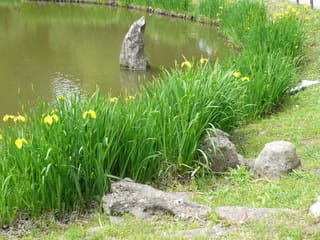前回は、本間家の本邸をご紹介しましたが、今回は別邸の話。
酒田駅の近くにある本間美術館は、本間家4代の光道が、文化10年(1818)に建てた別荘でした。「酒田の迎賓館」として、藩主や幕府要人、明治以降は皇族や政府高官の宿泊施設としても利用された建物です。注目すべきは、この建造もまた、港湾労働者の冬期失業救済事業の一つだったそうです。
本館庭園は、四阿のそばの老松に鶴が飛んできたことから、酒井侯が「鶴舞園(かくぶえん)」と名付けたという池泉回遊式庭園です。佐渡の赤玉石、伊予の青石、鞍馬石など、北前船によって運ばれたという全国の名石がたくさん使われていて、当時の隆盛が窺われます。

(上: 鶴舞園)
植栽が密にすぎる気がしますが、高低差のある敷地が、変化のある景色を生み、眺めも抜群の庭です。
「清遠閣(せいえんかく)」と呼ばれる本館は、瀟洒な木造二階建て。二階部分は大正時代の建築で、窓に嵌められたガラスや電灯などに、モダンの香りが・・・。展示品は、本間家に代々伝わる古文書や拝領品などです。

(上: 清遠閣に至る八つ橋が風情豊か)
そしてもう一つ。私は、酒田と言えば本間家しか知らなかったのですが、本間家と並び称された東北地方の大地主・伊藤四郎右衛門の別邸跡が、やはり酒田駅の近くにあります。
明治24年築造の清亀園。パンフレットには「庭園は、当時50数名の門下を擁した名庭師・山田挿遊の手によるもの」と書かれていました。
和室を備えた建物とともに、現在は酒田市の生涯学習施設として一般に開放されている清亀園の庭園は、昭和54年に復元された池泉回遊式。昔は庭園内に田んぼもあった、というほど広大だったそうです。
今は規模もずいぶん縮小されているようですが、松、庭石、燈籠などが、要所要所に目を引く景色をつくり出し、名園の面影を漂わせています。

(上: 清亀園)
本間美術館: www.homma-museum.or.jp/
清亀園: JR酒田駅よりバス5分 TEL=0234-23-0388
---つづく---





























